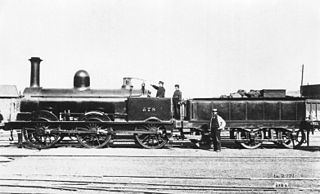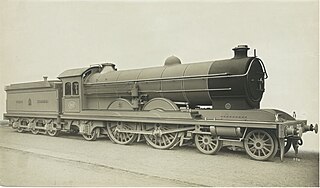| NER 708 class | |||||||||||||||||||||||
|---|---|---|---|---|---|---|---|---|---|---|---|---|---|---|---|---|---|---|---|---|---|---|---|
 708 Class | |||||||||||||||||||||||
| |||||||||||||||||||||||
| |||||||||||||||||||||||
| |||||||||||||||||||||||
The NER 708 Class was a class of 0-6-0 freight steam locomotive of the North Eastern Railway, designed by Edward Fletcher in 1870. A total of seventy-of the class were built for the NER.
| NER 708 class | |||||||||||||||||||||||
|---|---|---|---|---|---|---|---|---|---|---|---|---|---|---|---|---|---|---|---|---|---|---|---|
 708 Class | |||||||||||||||||||||||
| |||||||||||||||||||||||
| |||||||||||||||||||||||
| |||||||||||||||||||||||
The NER 708 Class was a class of 0-6-0 freight steam locomotive of the North Eastern Railway, designed by Edward Fletcher in 1870. A total of seventy-of the class were built for the NER.
The NER experienced a large increase in the volume of long-distance freight traffic from Newcastle and Darlington to York and Leeds during the late 1860s. Edward Fletcher therefore introduced a class of 0-6-0 freight locomotives with outside sandwich frames for this work. These were later classified by Wilson Worsdell as the 708 class, which was the first NER class to be built in large numbers. [1]
The first fifty locomotives were built at Newcastle by Robert Stephenson and Company (works numbers 1961–1980 and 2021–2050) between June 1870 and December 1871. These were numbered 706–755. As the class proved to be successful a further twenty were ordered from R and W Hawthorn (works numbers 1521–1540) and introduced between January 1872 and April 1873 (numbers 756–775). [2]
During 1872, Fletcher began to build an inside framed version of the class, with the NER 398 Class. Nevertheless, the locomotives continued to provide useful service until their withdrawal between 1903 and 1911. [2]
Two locomotives from the class suffered from boiler explosions. No. 737 in September 1879 and No. 746 in January 1880. Both locomotives were subsequently repaired and returned to service. [3]
George Whale was an English locomotive engineer who was born in Bocking, Essex, and educated in Lewisham, London. He worked for the London and North Western Railway (LNWR).

The North Eastern Railway (NER) was an English railway company. It was incorporated in 1854 by the combination of several existing railway companies. Later, it was amalgamated with other railways to form the London and North Eastern Railway at the Grouping in 1923. Its main line survives to the present day as part of the East Coast Main Line between London and Edinburgh.

Sir Vincent Litchfield Raven, KBE was an English railway engineer, and was chief mechanical engineer of the North Eastern Railway from 1910 to 1922.
The London and North Eastern Railway (LNER) produced several classes of locomotive, mostly to the designs of Nigel Gresley, characterised by a three-cylinder layout with a parallel boiler and round-topped firebox. It produced the most famous locomotive of its day, 4468 'Mallard', the holder of the world steam locomotive speed record. It also built the world-famous 4472 'Flying Scotsman'. However, its locomotive inheritance was much greater than just the 'A4 Class', it also produced highly successful mixed-traffic and freight designs.

The North Eastern Railway Class T2, classified as Class Q6 by the LNER, is a class of 0-8-0 steam locomotive designed for heavy freight, especially for hauling long coal trains to various collieries in the North Eastern region of the UK, with a maximum speed of 40 miles per hour. 120 were built at Darlington Works and Armstrong Whitworth between 1913 and 1921 to the design of Vincent Raven, based on the NER Class T and T1. The batch of fifty built by Armstrong Whitworth from 1919 were A-W's first locomotives to be built, after the conversion of their Scotswood works from ordnance to peacetime production.

The Race to the North was the name given by the press to occasions in two summers of the late 19th century when British passenger trains belonging to different companies would literally race each other from London to Edinburgh over the two principal rail trunk routes connecting the English capital city to Scotland – the West Coast Main Line which runs from London Euston via Crewe and Carlisle and the East Coast Main Line route from London King's Cross via York and Newcastle. The "races" were never official and publicly the companies denied that what happened was racing at all. Results were not announced officially and the outcomes have since been hotly debated. In the 20th century there were also occasions of competition for speed on the two routes.

The North Eastern Railway (NER) Class H, classified as Class Y7 by the London and North Eastern Railway (LNER) is a class of 0-4-0T steam locomotives designed for shunting.

The NER 901 Class was a class of 2-4-0 steam locomotive of the North Eastern Railway, designed by Edward Fletcher. Between 1872 and 1882 55 of the class were built for the NER.

The North Eastern Railway (NER) Bogie Tank Passenger (BTP) locomotives were designed by Edward Fletcher in 1873. The locomotives were for hauling passenger services on branch lines. They had an 0-4-4 wheel layout and a total of 124 locomotives were built. They were designated G6 by the London and North Eastern Railway (LNER).

The London and North Western Railway (LNWR) Prince of Wales Class was a class of express passenger locomotive. It was in effect, a superheated version of the Experiment Class 4-6-0.

The Scotswood, Newburn and Wylam Railway was a railway company that built the 6+1⁄2 miles (10.5 km) North Wylam branch or North Wylam loop on the former Newcastle & Carlisle Railway. The loop line opened between 1871 and 1876 and followed the former Wylam waggonway past the cottage where George Stephenson was born. The company was taken over by the North Eastern Railway in 1883.
The NER 38 Class was a class of 4-4-0 steam locomotives designed by Alexander McDonnell for the North Eastern Railway. Twenty-eight were built in 1884–5, and remained in service until 1915–23.

The London and North Western Railway (LNWR) DX Goods class was a class of 0-6-0 steam locomotive, designed by John Ramsbottom for freight duties. 943 were constructed, making them the largest single class of steam locomotives built in the United Kingdom. Despite this, none were preserved.

The NER B and B1 Classes were two classes of 0-6-2 tank locomotives designed by Thomas William Worsdell for heavy freight and mineral on the North Eastern Railway, introduced in 1886. They were tank engine versions of the NER C1 Class 0-6-0, using both simple expansion and also the von Borries configuration for two-cylinder compound locomotives. Both types were later rebuilt using superheated steam and the compounds were also rebuilt as simple expansion locomotives, and eventually formed a single class. Many of the superheated locomotives were also later returned to saturated steam as their original boilers wore out. As a result the classes have had a very complex mechanical history.
The North Eastern Railway was formed by merger in 1854 and merged into the London and North Eastern Railway at the grouping in 1923. Between those dates five men held the post of Locomotive Superintendent.

The NER Class R1 was a class of 4-4-0 steam locomotives of the North Eastern Railway. The class was designed by Wilson Worsdell and built from 1908 to 1909.

The 1825 to 1863 Stockton and Darlington Railway (S&DR) was the world's first public railway to use steam locomotives. Its first line connected collieries near Shildon with Stockton-on-Tees and Darlington, and was officially opened on 27 September 1825. While coal waggons were hauled by steam locomotives from the start, passengers were carried in coaches drawn by horses until carriages hauled by steam locomotives were introduced in 1833.

The NER Class V was a class of twenty steam locomotives of the 4-4-2 wheel arrangement. They were designed by Wilson Worsdell for the North Eastern Railway (NER) as express passenger locomotives.
The NER 398 Class was a class of 0-6-0 freight steam locomotive of the North Eastern Railway, designed by Edward Fletcher. in 1872. A total of 326 locomotives-of the class were built for the NER.

The NER Class Z was an Atlantic class of locomotives designed by Vincent Raven. It was introduced in 1911.